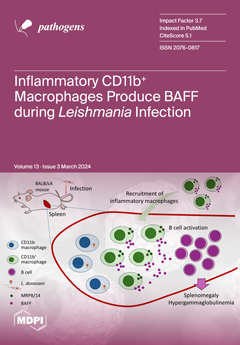Wickerhamomyces anomalus has been previously classified as
Hansenula anomala,
Pichia anomala, and
Candida pelliculosa and was recently reclassified in the genus
Wickerhamomyces after phylogenetic analysis of its genetic sequence. An increasing number of reports of human infections by
W. anomalus have emerged,
[...] Read more.
Wickerhamomyces anomalus has been previously classified as
Hansenula anomala,
Pichia anomala, and
Candida pelliculosa and was recently reclassified in the genus
Wickerhamomyces after phylogenetic analysis of its genetic sequence. An increasing number of reports of human infections by
W. anomalus have emerged, suggesting that this microorganism is an emerging pathogen. The present review aimed to provide data on the epidemiology, antifungal resistance, clinical characteristics, treatment, and outcomes of fungemia by
W. anomalus by extracting all the available information from published original reports in the literature. PubMed/Medline, Cochrane Library, and Scopus databases were searched for eligible articles reporting data on patients with this disease. In total, 36 studies involving 170 patients were included. The age of patients with fungemia by
W. anomalus ranged from 0 to 89 years; the mean age was 22.8 years, the median age was 2.2 years, with more than 37 patients being less than one month old, and 54% (88 out of 163 patients) were male. Regarding patients’ history, 70.4% had a central venous catheter use (CVC), 28.7% were on total parenteral nutrition (TPN), 97% of neonates were hospitalized in the neonatal ICU (NICU), and 39.4% of the rest of the patients were hospitalized in the intensive care unit (ICU). Previous antimicrobial use was noted in 65.9% of patients. The most common identification method was the matrix-assisted laser desorption/ionization time-of-flight mass spectrometry (MALDI-TOF MS) in 34.1%, VITEK and VITEK 2 in 20.6%, and ID32 C in 15.3%.
W. anomalus had minimal antifungal resistance to fluconazole, echinocandins, and amphotericin B, the most commonly used antifungals for treatment. Fever and sepsis were the most common clinical presentation noted in 95.8% and 86%, respectively. Overall mortality was 20% and was slightly higher in patients older than one year. Due to the rarity of this disease, future multicenter studies should be performed to adequately characterize patients’ characteristics, treatment, and outcomes, which will increase our understanding and allow drawing safer conclusions regarding optimal management.
Full article






